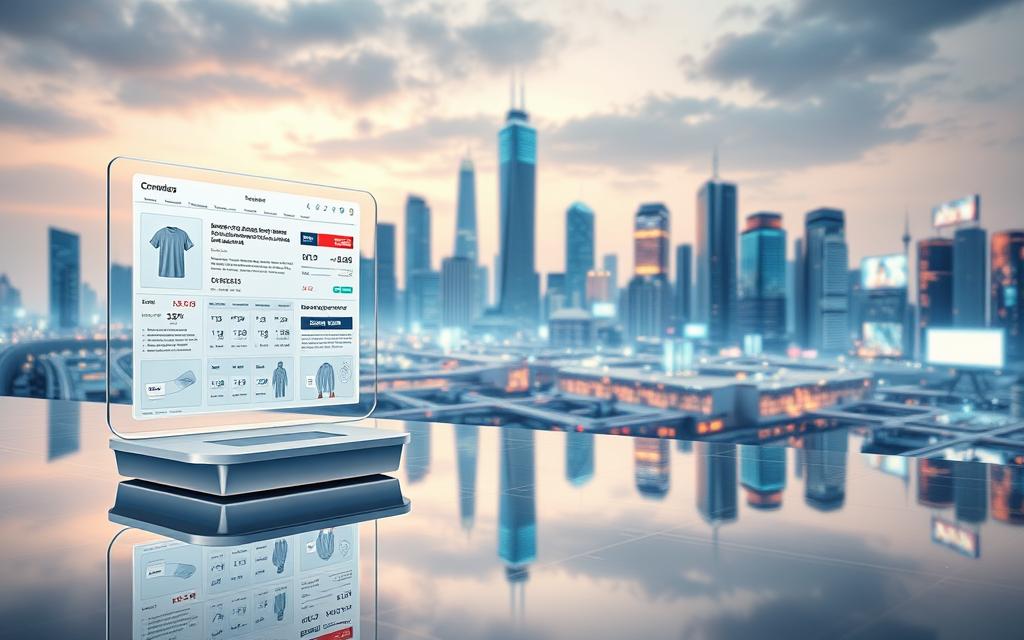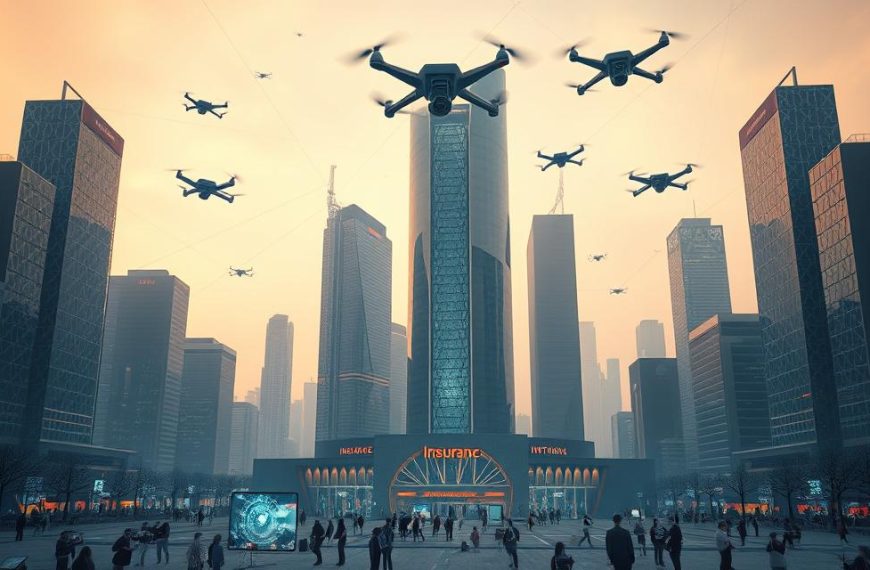Online retail has transformed global business-consumer interactions. E-commerce technology drives economic growth and consumer engagement. Retail ecommerce sales now make up over 19% of worldwide retail sales1.
Digital marketplaces allow businesses to reach customers beyond geographical limits. With over five billion internet users globally, online retail innovations reshape commercial landscapes1.
E-commerce ecosystems offer unique opportunities for entrepreneurs and established brands2. The growth of digital marketplaces is remarkable.
By 2027, ecommerce will likely comprise 25% of global retail sales. Global sales are expected to exceed $8 trillion1. This growth shows e-commerce’s power in connecting businesses with consumers worldwide.
The Evolution of Digital Marketplaces
Digital marketplaces have transformed how businesses and consumers interact online. These platforms have evolved from simple web stores into complex global ecosystems. They now support millions of sellers and generate billions in transactions3.
Global e-commerce has seen remarkable growth in recent years. Retail online sales now account for over 19% of worldwide retail transactions4. Third-party selling platforms are leading this digital transformation.
These platforms are expected to generate $3.832 trillion in Gross Merchandise Value by 20243. This figure highlights their significant impact on the global economy.
From Simple Stores to Global Powerhouses
Digital marketplaces have come a long way. Their journey shows impressive innovation and expansion. Key milestones mark their progress.
- Emergence of first online selling platforms
- Integration of advanced technological features
- Expansion of global market reach
The Rise of Third-Party Selling Platforms
Third-party selling has opened up online commerce for small and medium businesses. It allows them to reach global markets easily. China leads this trend, accounting for 62% of worldwide third-party sales3.
Impact of Mobile Commerce
Mobile commerce has changed digital marketplaces significantly. Platforms like Instagram and TikTok offer massive engagement opportunities. These platforms attract over 4.2 billion monthly visitors combined34.
E-commerce is set to grow even further. By 2027, it’s expected to represent nearly 25% of total global retail sales4. This prediction shows the ongoing evolution of digital marketplaces.
What are some unique features of e-commerce technology?
Digital marketplaces are changing how we shop with new tech. E-commerce platforms use advanced tech to create personalised, seamless shopping experiences. These innovations drive customer engagement and business growth5.
AI-Powered Personalisation
AI has transformed online shopping by offering tailored experiences. Machine learning studies customer behaviour to suggest products that match individual tastes5.
This smart approach can boost customer loyalty and increase sales6.
- Customised product suggestions
- Targeted marketing messages
- Predictive shopping experiences
Seamless Payment Solutions
E-commerce payment options have made buying much easier. Digital wallets and integrated systems reduce hassle, letting customers buy with little effort6.
The global digital wallet market has grown hugely. This shows rising demand for handy financial tech6.
| Payment Method | Convenience Level |
|---|---|
| Digital Wallets | High |
| One-Click Purchasing | Very High |
| Cryptocurrency | Emerging |
Real-Time Analytics and Insights
Real-time analytics offer crucial insights into consumer behaviour, stock management, and market trends. Companies use loads of customer data to make smart choices5.
The future of e-commerce lies in understanding and anticipating customer needs through intelligent technologies.
These tech features are improving shopping and boosting growth in online markets worldwide5.
Transformative Technologies in Modern E-commerce
Cutting-edge tech is reshaping how we shop online. Digital transformation is happening now, not in the future7.

New tech is changing e-commerce. It’s creating fresh ways for businesses to connect with shoppers. These changes offer exciting opportunities for innovative shopping experiences.
Augmented Reality Shopping Experiences
AR shopping lets customers see products in real-life settings. Virtual try-on experiences help people visualise items before buying7. This reduces return rates significantly.
A whopping 61% of online shoppers prefer platforms with AR features7. AR offers realistic product views and boosts customer engagement.
- Realistic product visualisation
- Reduced purchase uncertainty
- Enhanced customer engagement
Voice Commerce Integration
Voice commerce is changing how we shop online. Smart speakers and virtual assistants make shopping easier. By 2023, voice-based sales could hit £40 billion in the US8.
Voice commerce represents the next frontier of convenient, hands-free shopping experiences.
Blockchain for Secure Transactions
Blockchain is making e-commerce safer and more transparent. It improves supply chain management and builds trust. This tech also helps prevent fraud8.
- Enhanced transaction security
- Improved supply chain transparency
- Reduced fraudulent activities
These new technologies are changing online shopping forever. They’re not just trends, but major shifts in how we buy and sell online9.
Optimising Digital Marketplace Performance
Businesses must use cutting-edge tech to stay competitive in the digital marketplace. Data-driven e-commerce strategies are vital for understanding customer expectations10. Companies can drive growth by tracking key indicators and using advanced analytics tools10.
Customer experience optimisation is now crucial in the digital landscape. AI-powered chatbots and personalised systems create seamless interactions11. These solutions offer round-the-clock service and enhance engagement through tailored experiences11.
Over 80% of customers prioritise features like free shipping. This highlights the importance of meeting specific consumer expectations12.
Automated marketing solutions are changing customer acquisition and retention approaches. AI and machine learning allow for sophisticated targeting and personalisation strategies10.
E-commerce platforms now offer powerful tools for integrated marketing campaigns. These enable businesses to reach wider audiences more effectively12. By using advanced technologies, organisations can create efficient marketing approaches that boost growth.
FAQ
How have digital marketplaces transformed online retail?
What is AI-powered personalisation in e-commerce?
How are emerging technologies changing online shopping?
What payment innovations are transforming e-commerce?
How do real-time analytics benefit online businesses?
What role does mobile commerce play in digital marketplaces?
How are chatbots improving customer experience?
What is the significance of blockchain in e-commerce?
Source Links
- https://www.bigcommerce.com/articles/ecommerce/
- https://www.investopedia.com/terms/e/ecommerce.asp
- https://www.bigcommerce.co.uk/articles/omnichannel-retail/online-marketplaces/
- https://www.bigcommerce.co.uk/articles/ecommerce/
- https://medium.com/@ibrahimboyaci302/amazon-com-and-unique-features-of-e-commerce-technology-fb14c36284a7
- https://www.ogdenfulfilment.co.uk/top-e-commerce-innovations-shaping-the-future-of-online-shopping/
- https://appinventiv.com/blog/digital-transformation-in-the-ecommerce-industry/
- https://www.techaheadcorp.com/blog/digital-transformation-in-ecommerce/
- https://www.bigcommerce.co.uk/articles/ecommerce/digital-transformation/
- https://www.robinwaite.com/blog/the-rise-of-online-business-strategies-for-success-in-the-digital-marketplace
- https://purpleplanet.com/blog/the-latest-trends-and-technologies-in-e-commerce/
- https://www.theretailbulletin.com/retail-commentary/benefits-of-e-commerce-platforms-in-retail-20-12-2024/













